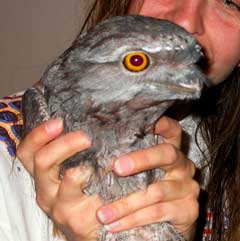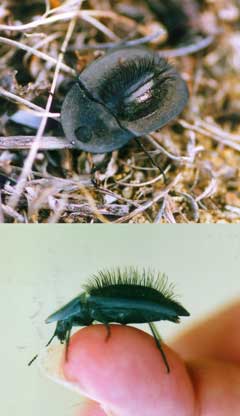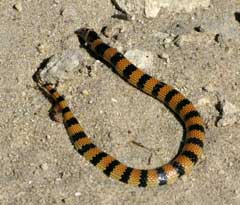Trigg Bushland is an important breeding and feeding area for a variety of birds, reptiles, insects and spiders. Bats still occur, but other mammals have largely disappeared.

Tawny frogmouth successfully returned to Trigg Bushland after being hit by a car
Sixty-five species of bird have been recorded. Some of the birds that live and breed in the bushland can also be seen foraging in surrounding suburban gardens. Others, such as the bronzewing pigeon and the white-winged fairy-wren, are found only in the bushland.
Birds likely to be seen include the white-cheeked honeyeater, Australian raven, magpie, ring-necked parrot, brown honeyeater, singing honeyeater, red wattlebird, and grey butcherbird. You may also see a black-shouldered kite or Australian kestrel hovering overhead. Harder to see are the small but colourful pardalotes, the white-browed scrubwren (rare in urban Perth ), the varied sittella (often seen walking head-first down tree-trunks), the rufous whistler, and grey fantail.

Pie dish beetle – PHOTOS PHYLIS ROBERTSON
The area is rich in reptiles. These include snakes, skinks, legless lizards, geckoes and dragon lizards.
In 2011 and again in 2012 there were unconfirmed sightings of an echidna in Trigg Bushland. There have also been regular sightings of quenda diggings. Echidnas and quendas are occasionally found in larger bushland areas, such as Whiteman Park, and any sighting in Trigg Bushland should be immediately reported to the Friends or City of Stirling. Please also take a photo, showing local landmarks, and keep a record of the area where sighted.
Feral animals, including rabbits, foxes and domestic cats and dogs, damage the reserve by eating young seedlings and regrowth, by preying on native species and encouraging weed growth where faeces is deposited. It would be preferable if rabbits and foxes could be eradicated, and domestic animals kept in accordance with guidelines set by the City of Stirling. The City of Stirling has prohibited cats in Trigg Bushland and a fine of $500 or euthanisation of the animal may apply. Additionally, any property within 200 meters of Trigg Bushland is in a ‘fauna protection zone’ and a special license is required to have more than one cat as a pet within this zone. Please see the City of Stirling website for details.
Download the Trigg Bushland Bird List (this is an extract, the full BirdlifeWA/Perth Biodiversity Project report can be found on the BirdlifeWA website here). To see which bird has been eating marri nuts, see Cockatoo Care’s chart here.
For assistance with injured animals contact the Wildcare Helpline on (08) 9474 9055 (24hrs) or see the Dept of Environment and Conservation’s Wildcare page.
Results from fauna trapping by DPaW Research Scientist Mark Cowan as provided to the City of Stirling:
| Presence between 1994 and 1997 at Trigg Dune sites | ||
| Species | Common name | External link |
| Aprasia repens | Sand plain worm-lizard | Photo link |
| Cryptoblepharis buccanani | Buchanan’s snake-eyed skink | Photo link |
| Ctenotus fallens | West-coast laterite ctenotus | Photo link |
| Ctenotus australis | Western limestone ctenotus | Photo link |
| Cyclodomorphus celatus | Western slender blue-tongue | Photo link |
| Strophurus spinigerus | Soft spiny-tailed gecko | Photo link |
| Hemiergis quadrilineata | Two-toed earless skink | Photo link |
| Lerista elegans | Elegant slider | Photo link |
| Lerista lineopunctulata | Dotted-line robust slider | Photo link |
| Lerista praepedita | Blunt-tailed west-coast slider | Photo link |
| Lialis burtonis | Burton’s legless lizard | Photo link |
| Menetia greyi | Common dwarf skink | Photo link |
| Morethia obscura | Shrubland morethia skink | Photo link |
| Mus musculus | House mouse | Photo link |
| Myobatrachus gouldi | Turtle frog | Photo link |
| Christinus marmoratus | Marbled gecko | Photo link |
| Pogona minor | Dwarf bearded dragon | Photo link |
| Pseudonaja affinis | Dugite | Photo link |
| Ramphotyphlops australis | Southern blind snake | Photo link |
| Tiliqua occipitalis | Western blue-tongued skink | Photo link |
| Tiliqua rugosa | Shingleback | Photo link |
| Ctenophorus adelaidensis | Western heath dragon | Photo link |
| Simoselaps bertholdi | Jan’s banded snake | Photo link |
| Neelaps calonotus | Black-striped snake | Photo link |
| Brachyurophis semifasciata | Southern shovel-nosed snake | Photo link |
| Presence summer/autumn 2013 | ||
| Species | Common name | External link |
| Aprasia repens | Sand plain worm-lizard | See above |
| Christinus marmoratus | Marbled gecko | See above |
| Ctenotus fallens | West-coast laterite ctenotus | See above |
| Cyclodomorphus celatus | Western slender blue-tongue | See above |
| Echiopsis curta | Burdick | Photo link |
| Hemiergis quadrilineata | Two-toed earless skink | See above |
| Lerista elegans | Elegant slider | See above |
| Lerista lineopunctulata | Dotted-line robust slider | See above |
| Lerista praepedita | Blunt-tailed west-coast slider | See above |
| Lialis burtonis | Burton’s legless lizard | See above |
| Morethia obscura | Shrubland morethia skink | See above |
| Mus musculus | House mouse | See above |
| Pogona minor | Dwarf bearded dragon | See above |
| Pseudonaja affinis | Dugite | See above |
| Ramphotyphlops australis | Southern blind snake | See above |
| Simoselaps bertholdi | Jan’s banded snake | See above |
| Strophurus spinigerus | Soft spiny-tailed gecko | See above |
| Tiliqua occipitalis | Western blue-tongued skink | See above |
| Tiliqua rugosa | Shingleback | See above |

Jan’s Banded Snake (Simoselaps bertholdi) found dead on track, run over by a mountain bicycle.



Recent Comments